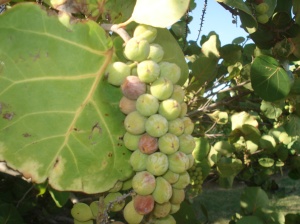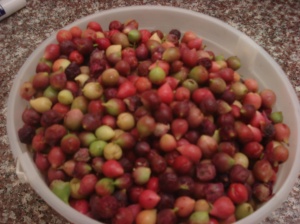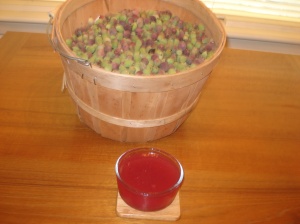Sea Grape Jelly brings to mind grapes growing by the seaside but that is not the true picture. Instead imagine a small tree (up to 30 ft. tall) loaded with bunches of green/purple fruit at the seaside. The fruit is mostly seed covered by some pulp. You can find this fruit in Texas from September through November. The leaves are large, glossy, and round.  The tree is common in the American tropics near ocean beaches. Sea Grape is useful not only for jelly and jam making but also for stabilizing dunes. It is common in Florida and less so in the southern tip of Texas.
The tree is common in the American tropics near ocean beaches. Sea Grape is useful not only for jelly and jam making but also for stabilizing dunes. It is common in Florida and less so in the southern tip of Texas.
Most people go to the beach to frolic in the waves but I go to make jelly. While my wife and her sister were sitting in a hot tub enjoying a fall day at the beach, I tried to find as many of the bunches of sea grapes that I could. That is easier said than done because even though it was halfway through the time for the fruit, there were few ripe ones on the tree. Where were the ripe ones? Looking at the ground held the answer. Most of the ripe ones had fallen to the ground. The fruit does not fall as a bunch, rather falling one at a time. Therefore the ripe ones fall off, often helped by the birds who seem to flock to the tree. What was I going to do to get enough ripe fruit? An earlier experiment had told me that if I picked the fruit green they would eventually ripen off the plant. So I picked every bunch of fruit that had at least three or four ripe fruit on it. I did that with a pair of garden pruners. Then at the hotel that night I sorted through the bunches, picking out the ripe ones and placing them in their own bucket. I had picked three buckets of fruit and ended up with one bucket of ripe fruit. The other two buckets slowly ripened when I took them home. However, one bucket of fruit (8 cups) was enough to make a good batch of the tasty jelly.
After washing the fruit to remove salt, sand, and insects, I measured out 8 cups of ripe fruit to pour into my jelly making kettle. I added just enough water to cover the fruit. I then boiled it long enough for the fruit to change color and get soft. I mashed up the fruit with my potato masher, I then poured juice and pulp into my food mill which mashed up the fruit even more.
This last step could be skipped on this fruit since the pulp does not come off the seed very easily. I then poured the juice through a cheese cloth. This gave me a juice that had a dark pink color. I then added the sugar, and then the no sugar needed pectin. The addition of the sugar changed the jelly to an attractive red color. After letting the jelly cool slightly I poured it into freezer containers. After the jelly had cooled and jelled, I placed the jelly into my freezer.
4 cups of Sea Grape juice
3 cups of sugar
1 pkg of no sugar needed pectin


Thanks for sharing. I am 71, my mother made it every year. My favorite, guava is close second.
Used to be able to buy sea grape but not lately.
I have come to realize that jellies, jelly making, fruit picking, or the whole process is all about memories. The memories of the first time we had a jelly, the time we accompanied our mother to pick dewberries or eating our mother’s Sea Grape jelly.
I have seen lots of different kinds of jelly for sale but I admit I have not seen Sea Grape Jelly for sale.
I am glad that we were able to bring back happy memories. That is what this all about for me.
I am from Florida and love sea grapes. I didn’t know until I read it in a book about Early Pinellas County life that you could make jelly out of it and in that book it said with prickly pears so you Texans can try that as well. Anyway that’s when I decided to look it up and found this site. I wonder what it tastes like?
Tracy-
What are the ways you have utilized sea grapes? Did you eat them fresh, cooked or in a jelly? Were you asking how cactus jelly tasted or were you asking how did the sea grape jelly taste? They both have unique tastes. The cactus jelly has a beautiful color unlike any other jelly. It is sort of a red-purple. The sea grapes make a red jelly. The sea grape does not have as much of a distinct flavor as the cactus jelly has. However, they both are great jellies. Interestingly enough prickly pear cactus is also native to the southern United States, including Florida. It is drought and heat tolerant. It does need a sunny, well-drained site. So if you don’t have any near you it should be possible to find some and plant it in your yard. In a short time you too will be able to have cactus fruit. And then you can make the cactus jelly. I have noticed that there are many places in Texas that sell cactus jelly.
Thanks so much for this recipe, I am going to give it a go!
Nancy- I am glad you are going to try this recipe. I know you will like it. It is a pretty and tasty jelly.